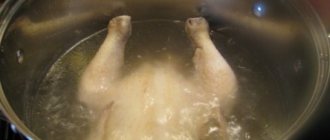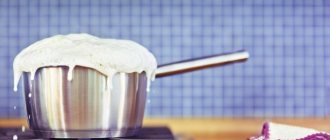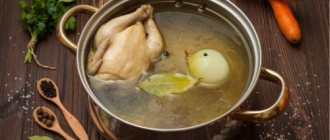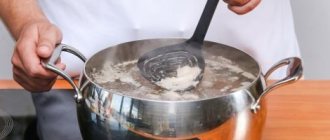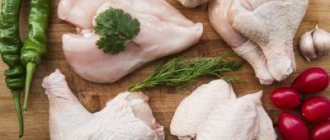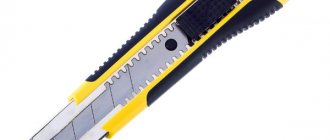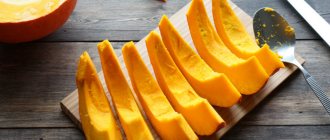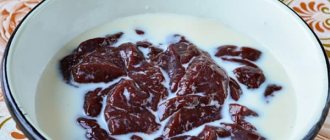This question, which worries many housewives, wanders from generation to generation. For my mother and me, it still remains unresolved. Do I need to skim off the foam when cooking meat? Many, including my mother, believe that it is necessary. She refers to the opinion of experts who declared scale to be the concentration of all substances harmful to the body. “When you cook broth, you should wait until it starts boiling and immediately skim off those gray flakes from its surface,” my mother constantly teaches, which is why real battles break out in our kitchen. Personally, I do not consider this issue to be fundamental, since I am familiar with a different point of view. What is the foam on the surface of borscht? Is it really so important to remove it and what is the best way to do it?
How and why
The answer is extremely simple: to get a beautiful clear broth. After all, even if you cook borscht, gray flakes of foam will look rather unpleasant in it. In addition, the pan will be more difficult to clean: the foam sticks tightly to its sides.
To remove the foam quickly and without unnecessary fuss, it is best to take a special spoon - it looks the same as a regular one, but with holes. The broth flows out through the holes, and gray foam settles on the spoon.
Another way is to throw an onion into the broth. The coagulated protein will stick to it and will not spoil the aesthetics of the dish with the appearance of unpleasant flakes. Some people recommend adding fried onions and carrots to the broth. But we won’t recommend this method: why weigh down the soup with extra fat?
And really desperate cooks strain the broth. To do this, you need to get a special piece of thick gauze. And besides, you will have to come to terms with the fact that after preparing the soup there will be one more pan of dirty dishes.
Source
Why you need to skim off the foam while cooking meat: mistakes housewives make
When we cook soup or broth, we notice foam forms on the surface of the pan. She certainly doesn't look the most appetizing. But it is important to understand that if the bird is raised by you, then it cannot be contaminated or harmful substances.
If you use poultry to prepare the broth, it contains a lot of protein. Foam is also a protein, but only already coagulated.
If the heating is slow, more proteins will be released. Blood can also increase the amount of foam. Because of this, the foam cap turns brown.
The quality of the meat itself, as well as the purity of the product itself, also plays a big role. For example, young veal produces much less foam than beef.
Photo: Pixabay
Why does foam appear on jam?
Everything you do with love turns out perfect - this rule applies in the kitchen when preparing any dishes. When we make jam for our household, we want everyone to like it, and also to be aromatic and tasty. This is why you have to follow the cooking rules and skim off the foam when the jam is boiling. Let's look at the nature of the appearance of the foam itself.
A lot of foam indicates the following reasons:
- berries or fruits are overripe and also include some unusable parts;
- jam ingredients are poorly washed;
- or they are carefully processed, but not dried;
- The dishes in which the jam is prepared are poorly washed and not sterilized.
Foam has several reasons for its appearance
How exactly do you need to get rid of foam in the broth?
Agree that too much foam looks very unsightly. Most housewives use all measures to get rid of it.
It is not necessary to scoop out the liquid. You can simply put an onion head in the broth. Thanks to it, the process of foam coming out of the meat will stop.
The quality of the product is also important.
It is best to give preference to meat that has not been chemically processed. It should also be free of blood contaminants. Choosing the right cut of meat will help ensure that too much foam comes out.
It will take about 20 minutes for the protein to dissolve on its own. This time is quite enough for processes to stabilize. Only a light yellowish trace of fat will remain on the surface of the broth.
If there is too much foam, your broth will become cloudy. When it cools down, a precipitate can be detected. But don't worry too much about this. The quality of your broth will not change. If there is little protein released, this will not affect the taste of the broth or its color.
The protein that is digested is useful in the same way as the one that is found in the meat itself. Only here it plays a big role that it is the protein itself that comes out, and not the harmful substances that may be contained in the meat.
Why else drain the first broth?
- The first option in which people drain the first water after boiling is when want to reduce the fat content of the soup and its calorie content. It all started with the great and terrible drying of various herbs, which thus turned the already not particularly tasty chicken breast into something rubbery and indigestible.
We still want to remind you that for proper nutrition and weight loss, it is not necessary to eat only low-calorie foods , but it is important to eat a varied and tasty diet.
Broth, which is more like salty empty water, is unlikely to give you satiety and pleasure, so we personally do not see any point in such an execution of a tasty, moderately fatty piece of meat.
- This method is used to keep the broth clear . Actually, we have already discussed this point above.
- To reduce the content of purine bases in food. This rule must be followed with many medical diets (No. 4,5,6,7,8,9), especially with gout, urolithiasis, diabetes, diseases of the liver, gall bladder, and biliary tract.
Purines themselves are not something absolutely harmful. These organic compounds form the building blocks of DNA and RNA and are found in many foods and are also synthesized by the body itself.
When a large amount of purines accumulates in the body, their excretion and utilization are disrupted, as a result of which a person’s well-being deteriorates.
This can lead to an increase in uric acid crystals, which begin to accumulate in the joints and favor the formation of gout.
Gout is a type of arthritis that is characterized by unbearable pain and severe inflammation. Therefore, to prevent uric acid from building up in the blood, a low-purine diet is often recommended for gout.
Meat, poultry and offal contain a lot of purine, but there is no need to give up these important nutritional elements: the fact is that purines are sensitive to temperature : for example, when cooking, purines from meat pass into the broth.
Is it necessary to remove the foam?
The dish tends to turn sour very quickly. The foam itself consists of the first coagulated proteins. For denaturation, 40 minutes is enough for them.
In addition to the fact that they cook quickly, such proteins can sour very quickly. If there is foam in a dish, it may disappear the very next day.
Foam can add bitterness and an unpleasant odor to the dish. This particular scent is not liked by many people. If there is an admixture of blood in the foam, it will even be slightly bitter. From this we can conclude that foam does not have the best effect on the taste of the dish.
A dish with foam looks ugly. After all, experienced cooks always strive for the broth to be as clear as possible. To do this, you not only need to remove the foam, but also strain the broth through cheesecloth. Professionals say that the first dish should be as transparent as possible so that all the ingredients are completely visible. Then the broth will look very beautiful and aesthetically pleasing.
Source
Broth foam: should it be removed?
Remove or leave: is foam on broth harmful?- The lead singer of the Lyapis Trubetskoy group beat up a spectator right on stage
- “The registration was a success”: the Internet is discussing a sex video with a 15-year-old schoolgirl at a party
- Is it possible to eat old honey?
- Putin promised to review the “blurred criteria” of the law on foreign agents
- Aziza's friend named the killer Igor Talkov
- The first interview with the “Russian Vanga” from Chita. NTV exclusive
- A Muscovite found her stolen car and was left without a license
- To whom did actor Panin give $500 thousand before his death?
- Without cafes, cinema and karaoke: how life in Moscow will change on non-working days
- A lockdown will be introduced in Moscow from October 28
- EU leaders blame Moscow for European gas crisis
- Maxi, gloves and vaccination in the midst of an epidemic: a doctor answered popular questions about
- Porn actress opens up in hospital room after gang rape
How I get rid of scale and oil on the surface of the broth in 1 minute
Broth is the basis not only for soups, but also for other dishes, for example, risotto; various sauces and dressings are made with its help. But at the same time, preparing the right broth is quite difficult. Many novice housewives often have difficulties with oil, fat and scale, which accumulate on the surface and spoil not only the appearance, but also the taste of the broth itself.
I'll tell you a simple method that I use to remove small cloudy particles in just a couple of minutes.
How do regular napkins help me?
Previously, like many, I used either a spoon or a slotted spoon. And if an ordinary spoon can remove most of the oil or scale, then a slotted spoon with its large holes is completely unsuitable - some of the foam will still seep back into the liquid. And it’s not very convenient to wash off the slotted spoon under water.
What am I doing? I take a regular paper napkin. First, I remove most of the fat and oil, and then put a napkin on the surface of the liquid for just a couple of seconds - all the small particles remain on it.
If necessary, I repeat the procedure several more times.
What are the two main factors for obtaining clear broth?
When preparing broth, you need to use cold, clean water. When food is placed in such water, the nutrients are almost completely digested, which will make the broth healthy. And thanks to slow heating, the appearance of scale (these are flakes of meat proteins that have curled up during the cooking process) is minimized.
In addition, do not forget that during the cooking process, water must cover all the food in the pan. It is better to immediately add more water; it is not advisable to add it.
Cook meat or vegetables over low heat, skim off the foam in time (Photo: culinaryginger.com)
Heating process
To prevent the water from boiling away and the entire cooking process to proceed properly, it is very important to heat the broth over low heat. This is what will minimize the appearance of scale that resembles foam. Therefore, I use napkins to clean the broth not only at the very beginning, as soon as scale and fat appear, but also at all stages of cooking.
And the liquid should barely boil - the higher the heat under the pan, the higher the likelihood of foam appearing and the broth boiling over.
What is jam foam and what does it consist of?
When the jam boils, foam appears almost immediately. In principle, there is no need to be afraid of her. It is harmless, but it has no beneficial qualities either. In other words, it is a protein that needs a temperature of 40 °C to cook and form into foam. Cooking rules state that it is necessary to remove foam. Therefore, let's “dig deeper” and understand what this white foam consists of.
- The cause of its formation leads to the first characteristic - it is dirt, and sometimes even particles of small debris. That is, a piece of a leaf, a badly torn tail and other delights from the garden, even insects.
- But the foam may contain more than just remnants of grains of sand if the food has not been washed properly. It can also be specks from sugar, poorly sterilized dishes or poor-quality water. All these elements easily fall into the foam.
- Before canning, it is very important to carefully sort all products not only from garbage, but also from rotten, damaged and spoiled fruit. After all, then protein fractions are released, which are part of the foam. And they can lead to swelling of the jar, souring of the jam itself, and even explosion of the lid.
- And, of course, extractive substances complement the list. Together with complex essential oils, which are present in each fruit in its own proportion, they interpret that distinctive aroma and taste.
Foam is harmless, but it has little benefit
What to do if transparency is not achieved?
If for some reason the broth is too dark (this often happens when it is not possible to remove all the foam), you can use the following methods to lighten it:
Regular protein copes well with cloudy broth (Photo: avrorra.com)
But I use a simpler option: I take peeled carrots and onions, put them in the broth and take them out immediately when it is ready. Thanks to this, the broth brightens significantly.
Source
What is the foam that forms when cooking meat?
Meat is a protein product; in addition, it has a high content of fat and even bone particles. Protein tends to coagulate at high temperatures. During cooking, the main part of it remains in the meat, but what is on the surface and close to it is released into the water, where it turns into a light foam that floats to the top.
The foam that appears when cooking meat is coagulated protein.
Fresh, properly cut meat gives a light foam - white or slightly grayish. Dark gray or brown foam indicates that there is a lot of blood left in the meat. It is she who, curled up, gives such a dirty color. In addition, the meat may not be washed well. All the debris remaining on it will be pushed to the surface of the broth by the coagulated protein.
Poultry meat forms the least amount of foam, but only if it is store-bought. Homemade chicken, duck, and turkey are rarely dry and lean. The owners feed the birds well so that they not only lay eggs, but are also tasty later. For example, when I cook homemade chicken soup, I have to stand over the pan until the broth begins to boil with all its might, so as not to miss an ounce of foam. You don’t have to bother with store-bought chicken at all.
Store-bought chicken produces very little foam
In second place in terms of the amount of foam formed is beef, and pork takes first place. Still, there is a dependence on the ratio of proteins and fats: the fattier the meat, the more intensely the protein is released into the water. But from my own experience I can say: dark, brown foam appears more often on beef broth.
How to make sure there is no foam?
When cooking meat, a lot of foam often forms, and you have to remove it more than once, especially if the water boils slowly. To do this, use a slotted spoon or a regular spoon. But there are secrets that will help reduce the formation of foam to nothing.
- Place the onion. The onion head will stop the denaturation process. The protein will curdle and the foam cap will no longer rise.
- Throw the meat into boiling water. In this case, it seems to be sealed, and the protein practically does not get into the water. But keep in mind that the broth will be less rich. But the meat itself will be as healthy and tasty as possible.
If foam particles remain and sink to the bottom, add a glass of ice water to the boiling broth. It will lift the cereal to the top. You can also get rid of the foam by straining through cheesecloth. You just need to let the broth sit for 15–20 minutes.
The covenant to skim off the foam while preparing broth is passed down from generation to generation. Many people argue that it contains all the harm. However, this is not quite true. It is removed due to its unaesthetic appearance, specific taste and smell. But in general it is not dangerous to health. The foam that forms when cooking meat is just coagulated proteins.
We recommend: How to brew hawthorn correctly in a thermos and how to drink it
Is it necessary to remove foam and why?
Curdled protein will not cause any harm to health. The only reason it is removed from the pan is because it looks unsightly. As soon as the water boils, the foam turns into unpleasant-looking flakes of varying sizes that are not so easy to catch. The broth becomes dark and cloudy. Therefore, the foam is removed immediately when it appears, before the water boils.
It is better to remove the dark, brown foam formed from the blood in the meat. Although it is no more harmful than regular blood, clotted blood has a specific taste that not everyone will like.
If the meat is fresh and clean, it is not necessary to remove the foam when cooking it.
It is imperative to remove foam contaminated with small particles of bone or debris from poorly washed meat. If you are in doubt about the origin of the meat (for example, it has been stored for a long time or, perhaps, has been chemically processed), it is better to do the following: wait until the broth boils, without removing the foam, and drain it. Pour fresh water over the meat and cook again.
The foam can be removed with a tablespoon or a slotted spoon. But it is most convenient to do this with a fine sieve for sifting flour. It perfectly passes clean broth and retains everything unnecessary.
These sieves for sifting flour will allow you to clear the broth from foam
If you still miss the moment and the foam curls into flakes, simply strain the broth through cheesecloth or a sieve. You can also pour a glass of cold water into the pan; this will cause the foam flakes to quickly rise to the surface, and you can easily collect them.
About hormones
Many are very afraid of hormones, which, as they put it, “inject” meat, so they drain this notorious first, and some second and third, broth.
However, it is important to understand that even if the use of hormones and other growth additives is used in the food industry, their concentration is strictly regulated and does not exceed the permissible limits!
In general, the hormones themselves in the feed have low bioavailability , i.e. poorly absorbed if obtained from food. That is why animals receive hormonal substances not with food, but by injection.
In the USA, according to standards, a cow after injection will have 24 mg. estradiol. If you eat a 500g steak, there will be a maximum of 0.18 micrograms of it. And our body will absorb 40-1000 times less than the amount of estradiol that is synthesized every day within ourselves.
In addition, most of the hormone obtained in this way is deactivated in the gastrointestinal tract and liver.
In general, antibiotics and hormones are indeed partially destroyed by heat treatment. Studies have shown that boiling destroys 20% of these substances. In chicken remains from 5.9% to 11.7%.
However, in order to get rid of everything unnecessary along with the first broth, you need to boil the chicken in the first water for at least 30 minutes, and the beef for 1 hour. In this case, 70% of the drugs go into the broth.
After this, the water is drained and the essentially boiled meat is cooked again, but for no more than 40 minutes. It turns out, of course, not soup, but water with boiled meat.
But we remind you that in Russia hormones are prohibited in animal husbandry , so is it worth even bothering with?
If you still think that our laying hens are stuffed with hormones, then you have simply never kept broilers at home. Believe me, they really gain a decent amount of weight in a short period of time without any special hormones, on one compound feed!
An interesting and extremely useful fact: the manufacturer has the right to produce food products according to its Technical Specifications (TS) or Organization Standards (STO).
This means that salt solutions can be injected into the meat to make it juicier, heavier and take less time to cook. Phosphates, starch, soy flour, milk proteins and other components that retain moisture are also used.
But in this case, if the chicken is specially soaked in a saline solution, it can no longer be called chicken or chicken, but is supplied as “semi-finished chicken for frying . But nothing else can be added to chicken produced in accordance with GOST.
So read the labels carefully.
